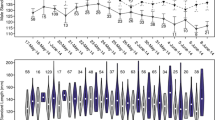Abstract
In the pipefish Syngnathus typhle, only males brood embryos in specially developed brood pouches, supplying oxygen and nutrients. Laboratory studies have shown that this elaborate paternal care has led to sex-role reversal in this species: males limit female reproductive rate, females are the primary competitors for mates and males exercise greater selectivity in accepting mates. In the first field study of this pipefish, we describe mating behaviour in the wild and test the hypothesis that temporal variations in the operational sex ratio (OSR) determine sex differences in mating behaviour. Our study comprised two reproductive seasons of two sequential mating periods each, the latter separated by a lengthy interval of male brooding. During mating periods, females displayed to all males without wandering and males moved about searching for females, without reacting to all females. The OSR was least female-biased (or even male-biased) at the onset of the breeding season, when most pipefish were simultaneously available to mate, but became strikingly female-biased as males' pouches were filled. The OSR remained substantially female-biased during the second mating period, because few males became available to remate at any one time. As hypothesised, female-biased OSRs resulted in more female-female meetings. As well, females were above the eelgrass more often than brooding males, thus exposing themselves to conspecifics and/ or predators. In the second year, males arrived earlier than females on the breeding site and male pregnancies were shorter, because of higher water temperatures, so rematings occurred earlier. Males met more often during that year than the previous one, but male competitive interactions were still not observed. The field results support laboratory studies and demonstrate that behaviours associated with female-female competition are more prominent when the OSR is more female-biased.
Similar content being viewed by others
References
Ahnesjö I (in press) Temperature affects male and female potential reproductive rates differently in the sex-role reversed pipefish Syngnathus typhle. Behav Ecol
Andersson M (1982) Female choice selects for extreme tail length in a widowbird. Nature 299:818–820
Bateson P (1983) Mate choice. Cambridge University Press, Cambridge
Berglund A (1991) Egg competition in a sex-role reversed pipefish: subdominate females trade reproduction for growth. Evolution 45:770–774
Berglund A (1994) The operational sex ratio influences choosiness in a pipefish. Behav Ecol
Berglund A, Rosenqvist G (1990) Male limitation of female reproductive success in a pipefish: effects of body-size differences. Behav Ecol Sociobiol 27:129–133
Berglund A, Rosenqvist G (1993) Selective males and ardent females in pipefishes. Behav Ecol Sociobiol 32:331–336
Berglund A, Rosenqvist G, Svensson I (1986) Mate choice, fecundity and sexual dimorphism in two pipefish species (Syngnathidae). Behav Ecol Sociobiol 19:301–307
Berglund A, Rosenqvist G, Svensson I (1988) Multiple matings and paternal brood care in the pipefish, Syngnathus typhle. Oikos 51:184–188
Berglund A, Rosenqvist G, Svensson I (1989) Reproductive success of females limited by males in two pipefish species. Am Nat 133:506–516
Clutton-Brock TH (1988) Reproductive success: studies of individual variation in contrasting breeding systems. University of Chicago Press, Chicago
Clutton-Brock T, Vincent ACJ (1991) Sexual selection and the potential reproductive rates of males and females. Nature 351:58–60
Clutton-Brock TH, Parker GA (1992) Potential reproductive rates and the operation of sexual selection. Q Rev Biol 67:437–456
Colwell MA, Oring LW (1988) Sex ratio and intrasexual competition for mates in a sex role reversed shorebird, Wilson's phalarope (Phalaropus tricolor). Behav Ecol Sociobiol 22:165–173
Darwin C (1871) The descent of man and selection in relation to sex. John Murray, London
Emlen ST, Oring LW (1977) Ecology, sexual selection and the evolution of mating systems. Science 197:215–223
Fiedler K (1954) Vergleichende Verhaltensstudien an Seenadeln, Schlangennadeln und Seepferdchen (Syngnathidae). Z Tierpsychol 11:358–416
Fisher RA (1930) The genetical theory of natural selection. Oxford University Press, Oxford
Gronell AM (1984) Courtship, spawning and social organisation of the pipefish, Corythoichthys intestinalis (Pisces: Syngnathidae) with notes on two congeneric species. Z Tierpsychol 65:1–24
Gwynne DT, Simmons LW (1990) Experimental reversal of courtship roles in an insect. Nature 346:172–174
Ichikawa N (1989) Breeding strategy of the male brooding water bug, Diplonychus major, Esaki (Heteroptera, Belostomatidae) is male back space limiting ? J Ethol 7:133–140
Kraus WF (1989) Is male backspace limiting ? An investigation into the reproductive demography of the giant water bug, Abedus indentatus (Heteroptera: Belostomatidae). J Insect Behav 2:623–648
Kruse KC (1990) Male backspace availability in the giant water bug (Belostoma flumineum Say). Behav Ecol Sociobiol 26:281–289
Kvarnemo C (in press) Temperature differently affects male and female reproductive rates in the sand goby. Proc R Soc London B
Kynard BE (1978) Breeding behaviour of a lacustrine population of threespine sticklebacks (Gasterosteus aculeatus L.). Behaviour 67:178–207
Madsen T, Shine R (1993) Temporal variability in sexual selection acting on reproductive tactics and body size in male snakes. Am Nat 141:167–171
Møller AP (1988) Female mate choice selects for male sexual tail ornament in the monogamous swallow. Nature 332:640–642
Sokal RR, Rohlf FJ (1980) Biometry. Freeman, New York
Svensson I (1988) Reproductive costs in two sex-role reversed pipefish species (Syngnathidae). J Anim Ecol 57:929–942
Tejedo M (1988) Fighting for females in the toad Bufo calamita as is affected by the operational sex ratio. Anim Behav 36:1765–1769
Vincent ACJ (1990) Reproductive ecology of seahorses. PhD Thesis, University of Cambridge
Vincent ACJ, Ahnesjö I, Berglund A, Rosenqvist G (1992) Pipefishes and seahorses: are they all sex role reversed ? Trends Ecol Evol 7:237–241
Wootton RJ (1979) Energy costs of egg production and environmental determinants of fecundity in teleost fishes. Symp Zool Soc London 44:133–159
Zuk M, Johnson K, Thornhill R, Ligon JD (1990) Mechanisms of female choice in red jungle fowl. Evolution 44:477–485
Author information
Authors and Affiliations
Additional information
Correspondence to: A. Vincent
Rights and permissions
About this article
Cite this article
Vincent, A., Ahnesjö, I. & Berglund, A. Operational sex ratios and behavioural sex differences in a pipefish population. Behav Ecol Sociobiol 34, 142–435 (1994). https://doi.org/10.1007/BF00167335
Received:
Accepted:
Issue Date:
DOI: https://doi.org/10.1007/BF00167335




